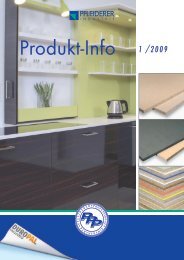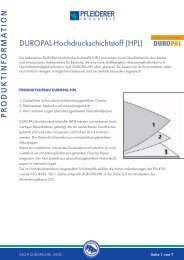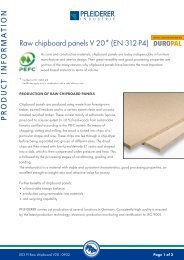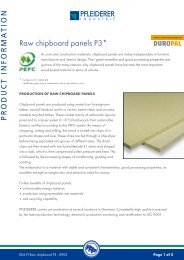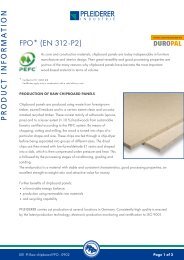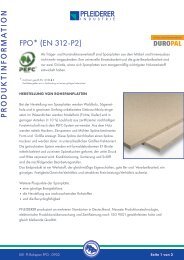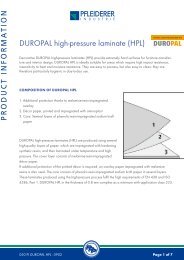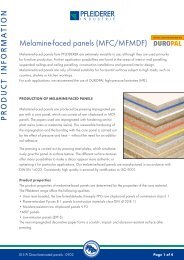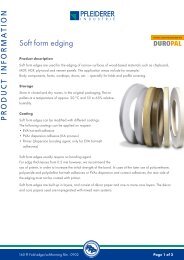Processing and working instructions HPL and HPL elements PR ...
Processing and working instructions HPL and HPL elements PR ...
Processing and working instructions HPL and HPL elements PR ...
You also want an ePaper? Increase the reach of your titles
YUMPU automatically turns print PDFs into web optimized ePapers that Google loves.
<strong>PR</strong>ODUCT INFORMATION<br />
Both systems require sufficient heat to enable the subsequent post-forming. Thin DUROPAL high-pressure<br />
laminates require only a short heating period, <strong>and</strong> must be processed correspondingly faster. With continuous<br />
post-forming, the bending should begin at the end of the heating input. Any machine systems should<br />
be run up to their ideal dosing before the actual post-forming procedure, since every material responds<br />
better to a different speed <strong>and</strong> temperature. It is important that the DUROPAL <strong>HPL</strong> is exposed to uniform<br />
heat throughout the whole cross-section before the bending process is started. The corresponding required<br />
temperature depends on the laminate thickness, the surface texture <strong>and</strong> the bend profile.<br />
For continual processing machines, the maximum heating output must be set at the corresponding variable<br />
speed. Continuous post-forming should be carried out if possible using a fixed bending block.<br />
For stationary machines, a test run should be carried out in order to determine the optimum heat effect in<br />
relation to the bending speed. This should ideally be started at a high temperature, <strong>and</strong> the speed adjusted<br />
accordingly. With heating rails, the initial duration should be kept short, <strong>and</strong> maintained continuously<br />
during post-forming.<br />
Avoid too low a temperature in order to prevent the formation of cracks. Discoloration can occur if the<br />
temperature effects are too high, sometimes also accompanied by cracking, deformation or blistering.<br />
Post-forming properties of DUrOPAL real metal laminates<br />
All DUROPAL real metal laminates are produced in post-forming quality. At a thickness of 0.8 mm, a radius<br />
of 8 mm or larger can be produced for brushed surfaces, <strong>and</strong> a radius from 10 mm upwards for smooth<br />
surfaces.<br />
099 PI <strong>Processing</strong> <strong>and</strong> <strong>working</strong> <strong>instructions</strong> Page 24 of 34



